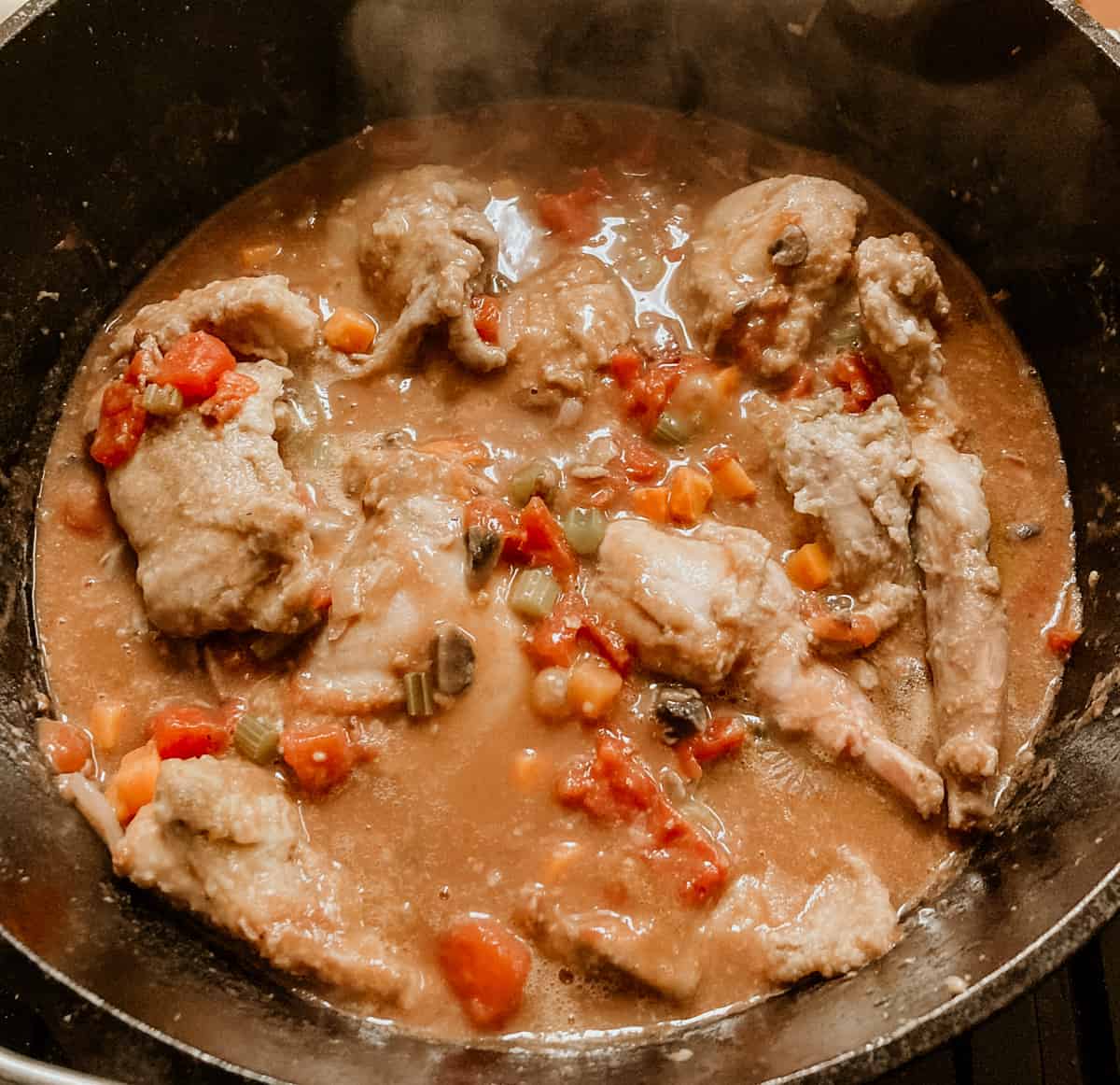
"Long before Italian food had any influence on what Australians were cooking, many Australian recipes for rabbit had all the hallmarks of the Italian classic dish called cacciatore, or hunter's stew. Recipes from the late 1800s cook rabbit with onions, bacon, parsley, and stock. All that was missing was the red wine and tomatoes. But these ingredients did come with European immigration to Australia in the 1950s, as did peppery pancetta, a worthy substitute for bacon."
- Chef Ross Dobson
We have a special kitchen experience for you today and we'd love for you to try it. Are you ready to make an amazing rabbit stew recipe that will have you rethinking your favorite go-to protein?
Grab your free printable recipe with pics at the bottom and discover a new favorite meal for your family as you learn how to cook rabbit together.
Learn more about cooking with kids.
If you enjoy this recipe, you should check out oxtails and pork belly.
Disclosure of Material Connection: Some of the links in the post are “affiliate links.” This means if you click on the link and purchase the item, I will receive an affiliate commission. Amazon links are not affiliate links. You can read my full affiliate disclosure.
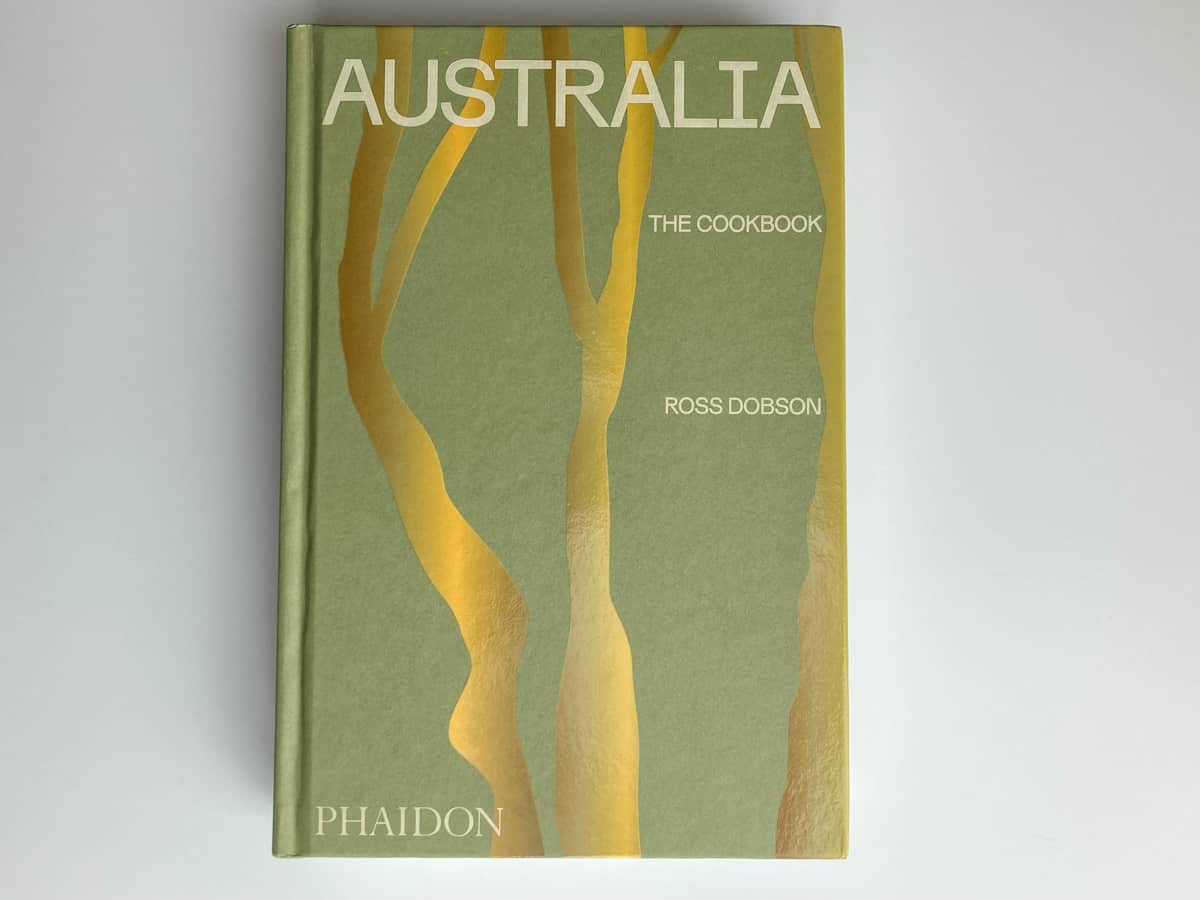
This delicious rabbit stew recipe comes from Australia: The Cookbook by Chef Ross Dobson. We recently made this barbecue prawns recipe from the same cookbook and we couldn't wait to try out this savory rabbit stew.
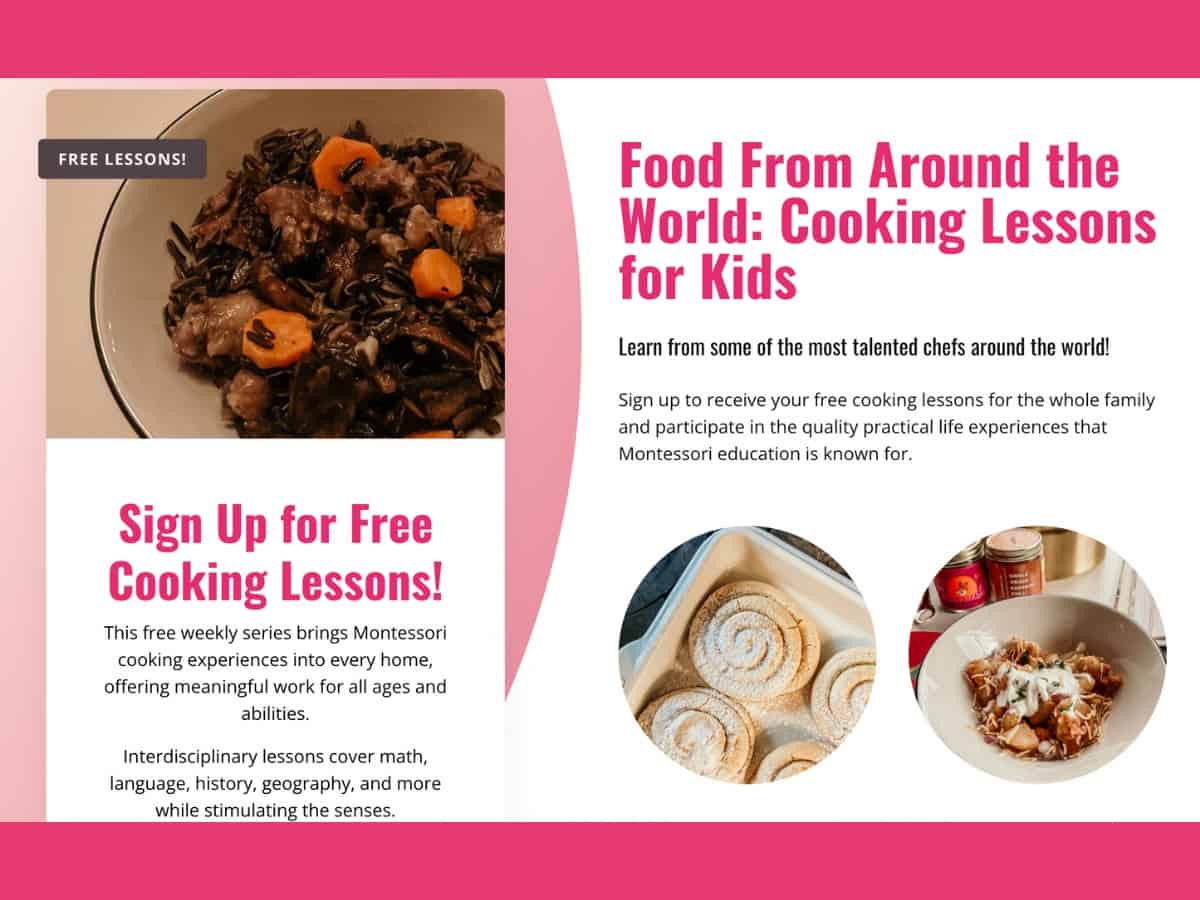
Free Cooking Course for Families
Discover recipes for every continent! Sign up to receive free cooking lessons for the whole family. Learn from some of the most talented chefs around the world, including Ross Dobson, and participate in the quality practical life experiences Montessori education is known for.
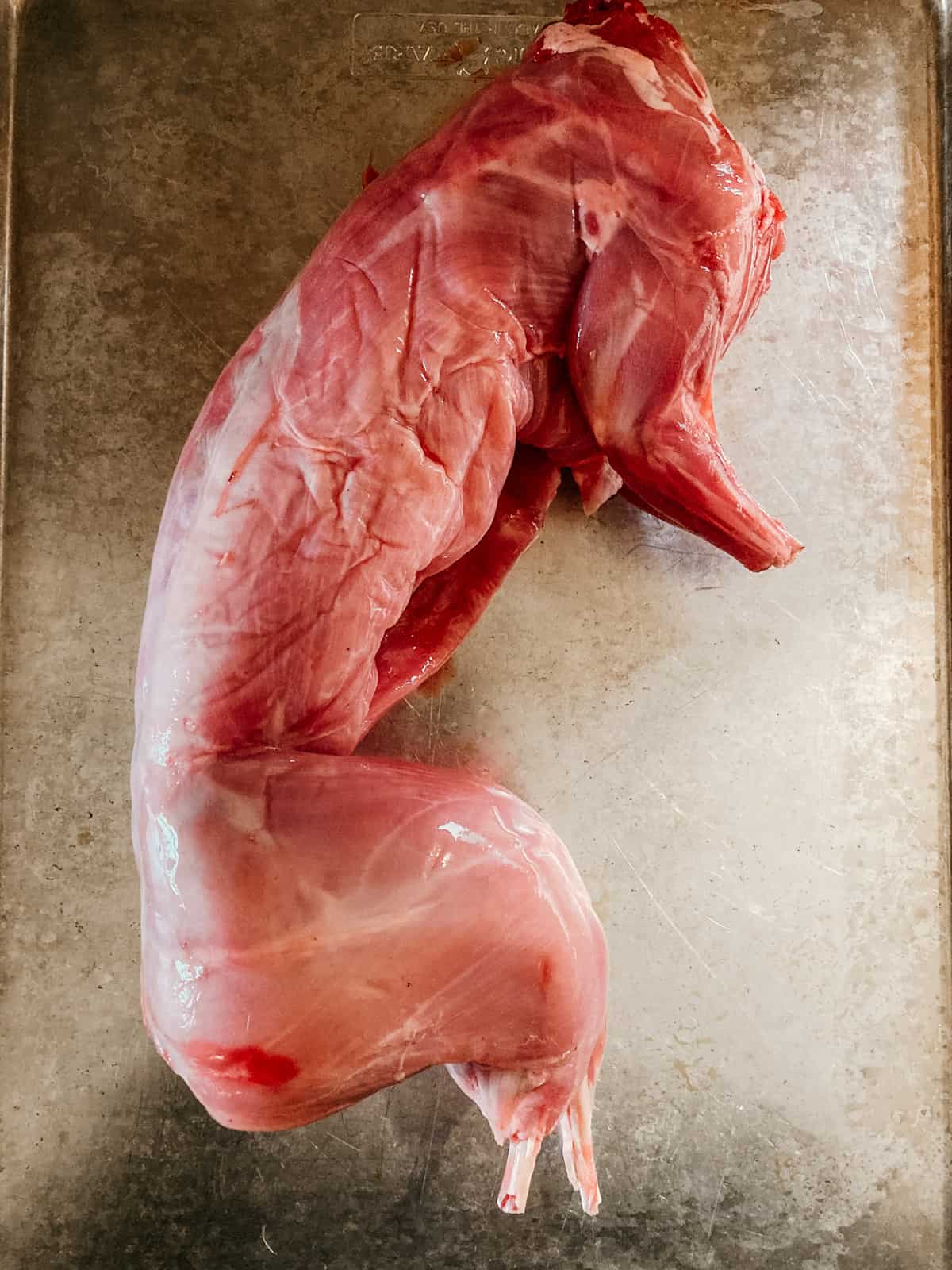
What Does Rabbit Taste Like?
Rabbit is tender meat with a mild flavor. If you're concerned about gaminess, or tough-textured meat with a strong taste, you're not going to find that here. If you like chicken, then rabbit should be your next adventure in the kitchen.
Wondering How to Cook Rabbit?
Fryers or young rabbits can be prepared in many of the same ways as your favorite chicken recipes. With mature rabbits, you may prefer braised or stewed rabbit recipes.
We've enjoyed braised, poached, smoked, and fried rabbit preparations. I'm looking forward to roasting rabbit next time I work with one.
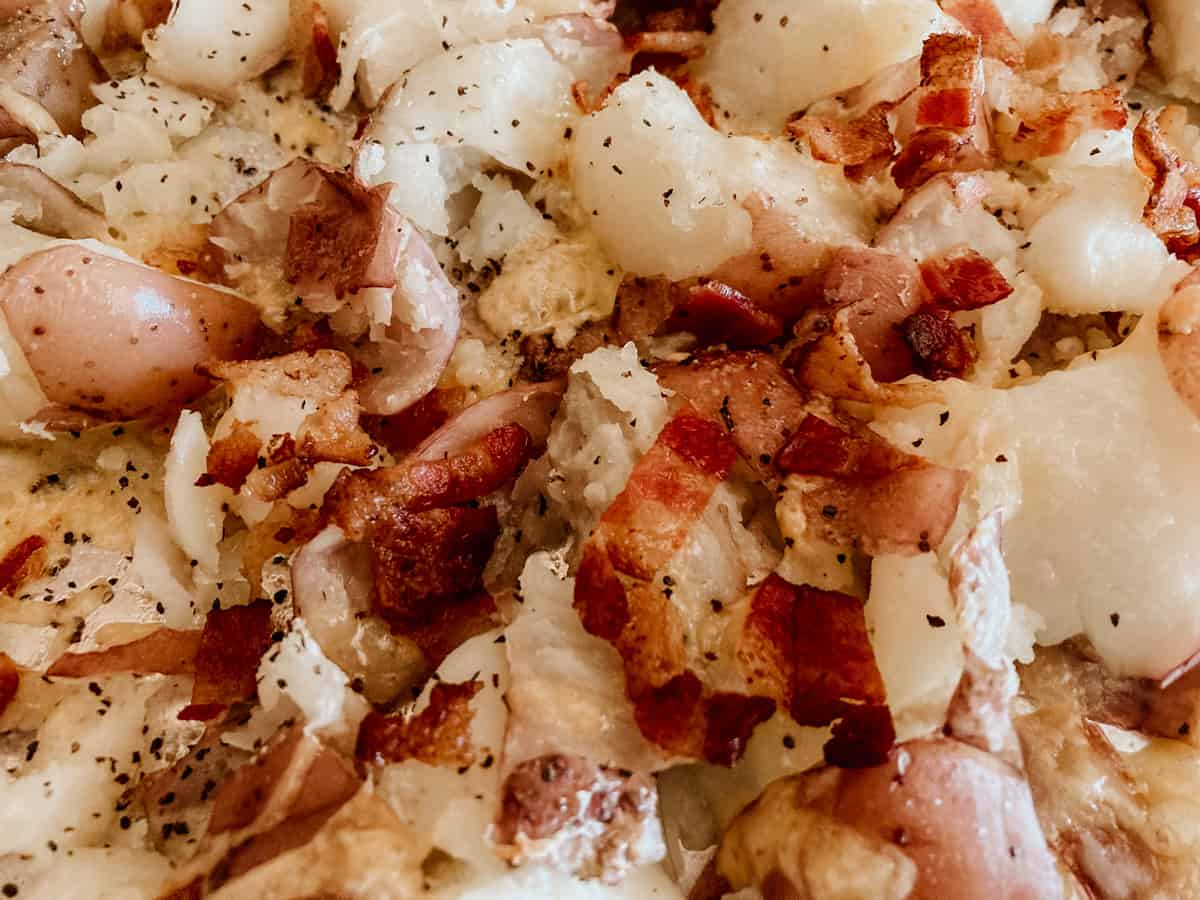
Wondering What to Serve with This Rabbit Stew Recipe?
This Australian rabbit stew recipe calls for mashed potatoes. We enjoyed these smashed red potatoes as a quick, simple, and flavorful side to complement this stew.

Australian Rabbit Stew Recipe
We're going to show you how to make rabbit stew using minimal equipment and simple tools. Everything is prepared in a dutch oven or large pot. Just make sure you have a sharp knife to butcher the rabbit and you're on your way.
Use caution when preparing this meal with kids. Bones are a choking hazard.
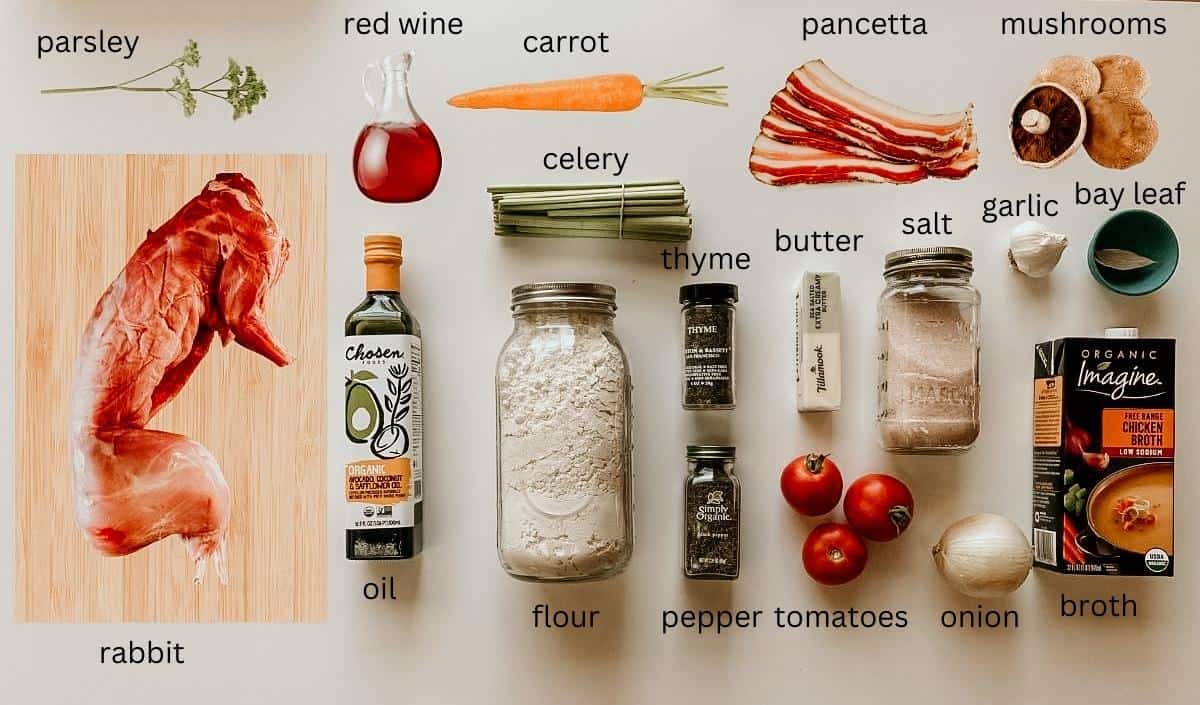
Ingredients
- Whole Rabbit (approx. 2 ¼ lb)
- All-Purpose Einkorn Flour
- Salted Butter
- Avocado Oil
- Pancetta or Bacon
- Onion
- Garlic
- Carrots
- Celery
- Thyme
- Bay Leaves
- Portobello Mushrooms
- Pinot Noir or Other Dry Red Wine
- Tomatoes
- Chicken Stock or Broth
- Parsley
- Salt
- Pepper
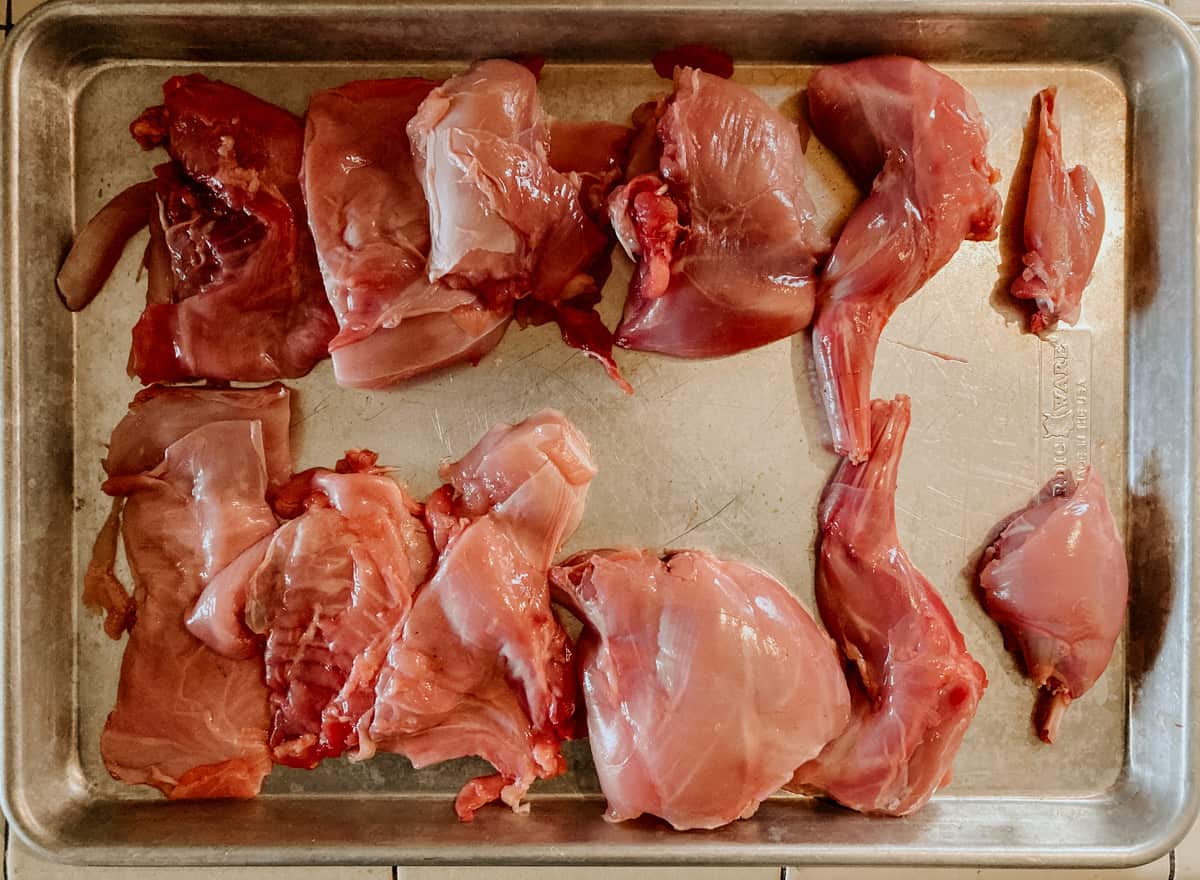
1. Cut the Rabbit into 12 Pieces
Whether you're raising rabbits or buying them from a rabbitry or butcher, they're generally packaged whole (minus the head) just like you would find with a whole chicken.
However, you can always ask to have them butchered for you and see if it's worth your while. If you've ever broken down a chicken, you may notice this is easier, in my opinion.
Depending on the ages and abilities of those involved, this may be an activity that parents or caregivers model for kids. Our kids are too young for this task but they happily watch and make observations.
We most commonly butcher rabbit into 8 cuts of meat. This recipe calls for 12, so it's not much additional knife work and it makes the perfect size cuts for rabbit stew.
Wash your hands with soap and water prior to getting started.
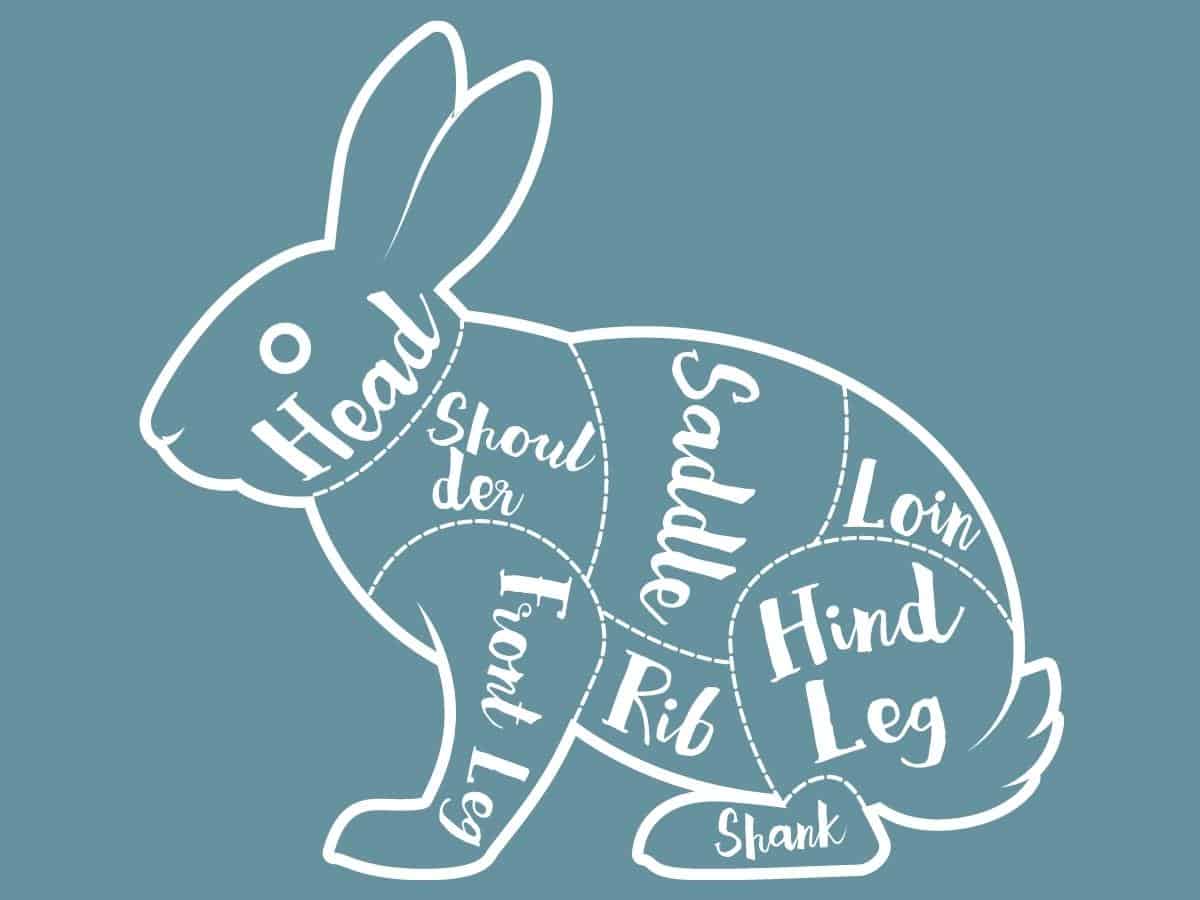
First, the hind legs are removed at the joint. Cut the hind legs crosswise in the center to separate the shanks. That gives you 4 pieces total.
Next, the front legs are removed to give you 2 more pieces.
Finally, the saddle is cut in half lengthwise down the center, and then each half is cut into 3 pieces, for a total of 6 pieces.
You can save the backbone for your bone broth and wash your hands.
While our kids are learning how to break down a rabbit they're also thumbing through Australia: The Cookbook, exploring the history, landscape photography, and recipes contained inside.
Several of these diverse cookbooks contain rabbit recipes, and we're excited to share this one with you today.

2. Weigh the Flour
Weigh the flour using a kitchen scale. Add salt and pepper to season the flour.
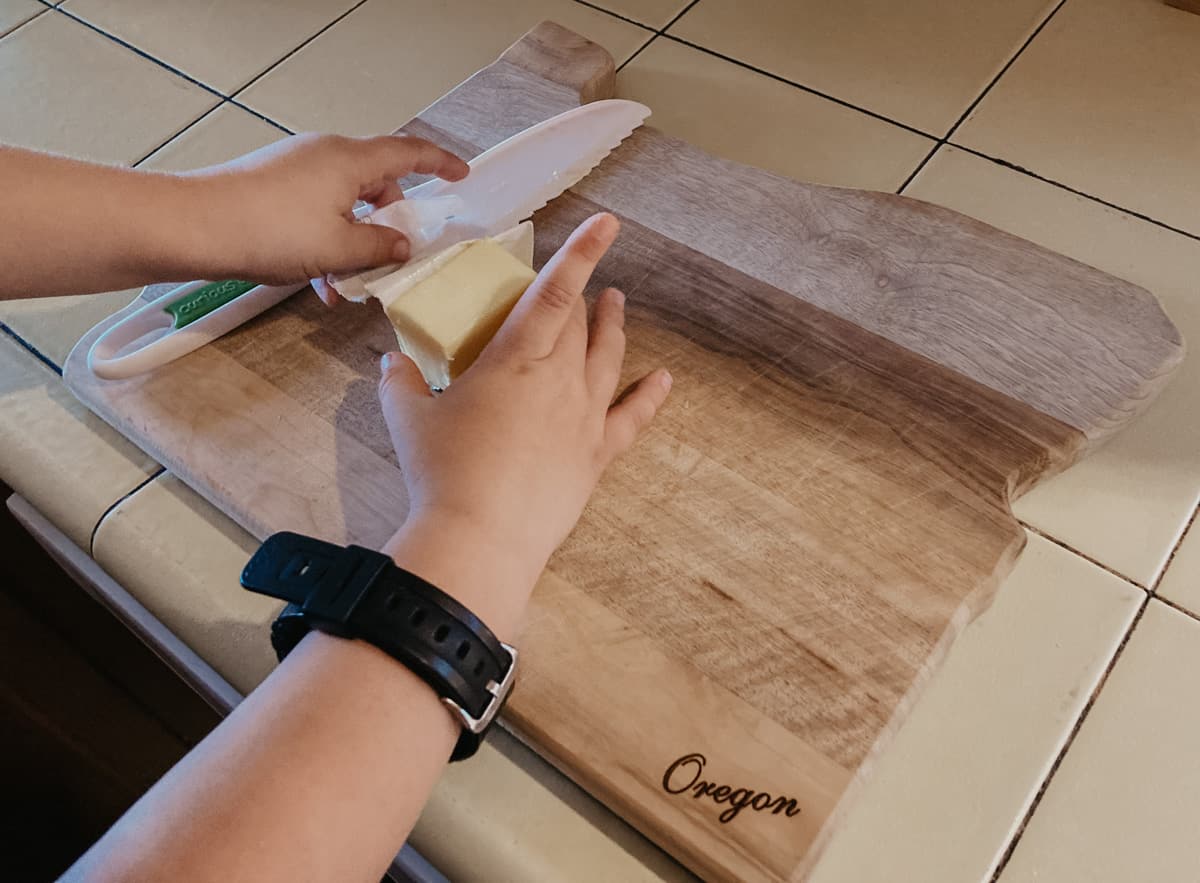
3. Add the Butter and Oil to the Pot
Turn the stove on medium heat. When the dutch oven or pot is hot, add the butter and oil.
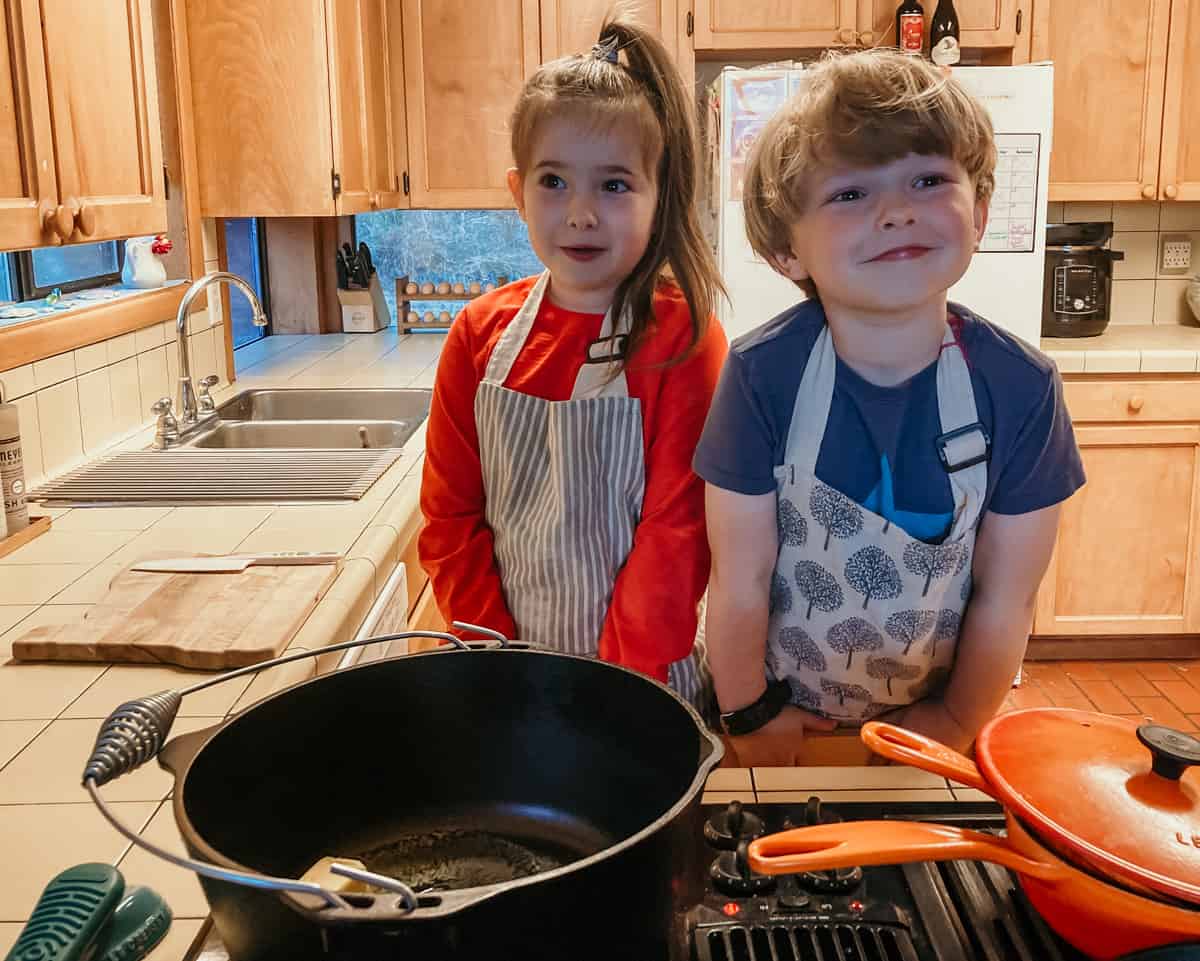
Thinking about how delicious this is going to taste.

When the butter has melted, you're ready for the next step.
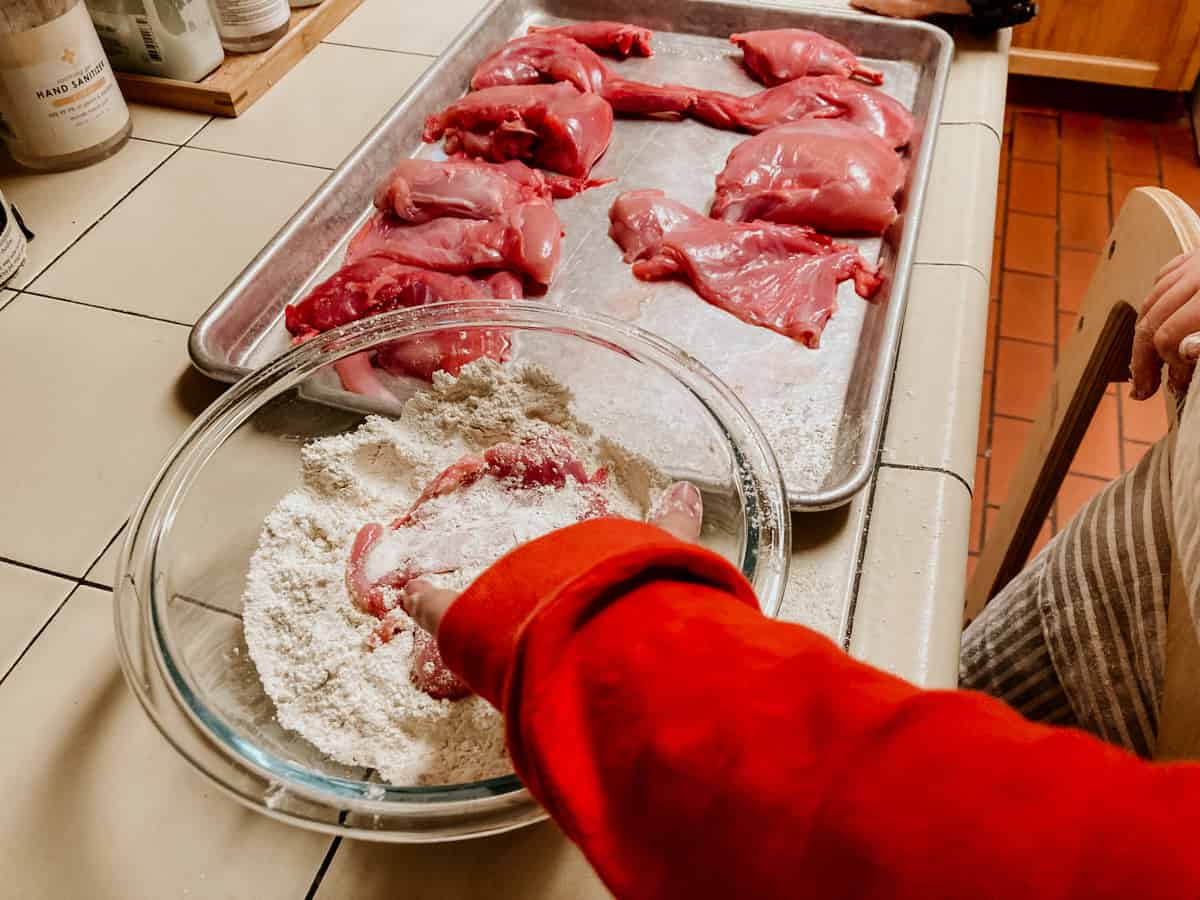
4. Coat the Rabbit Pieces in the Flour Mixture
Coat the pieces in the flour. Kids can place each piece in the flour mixture and then flip them over to coat the other side.
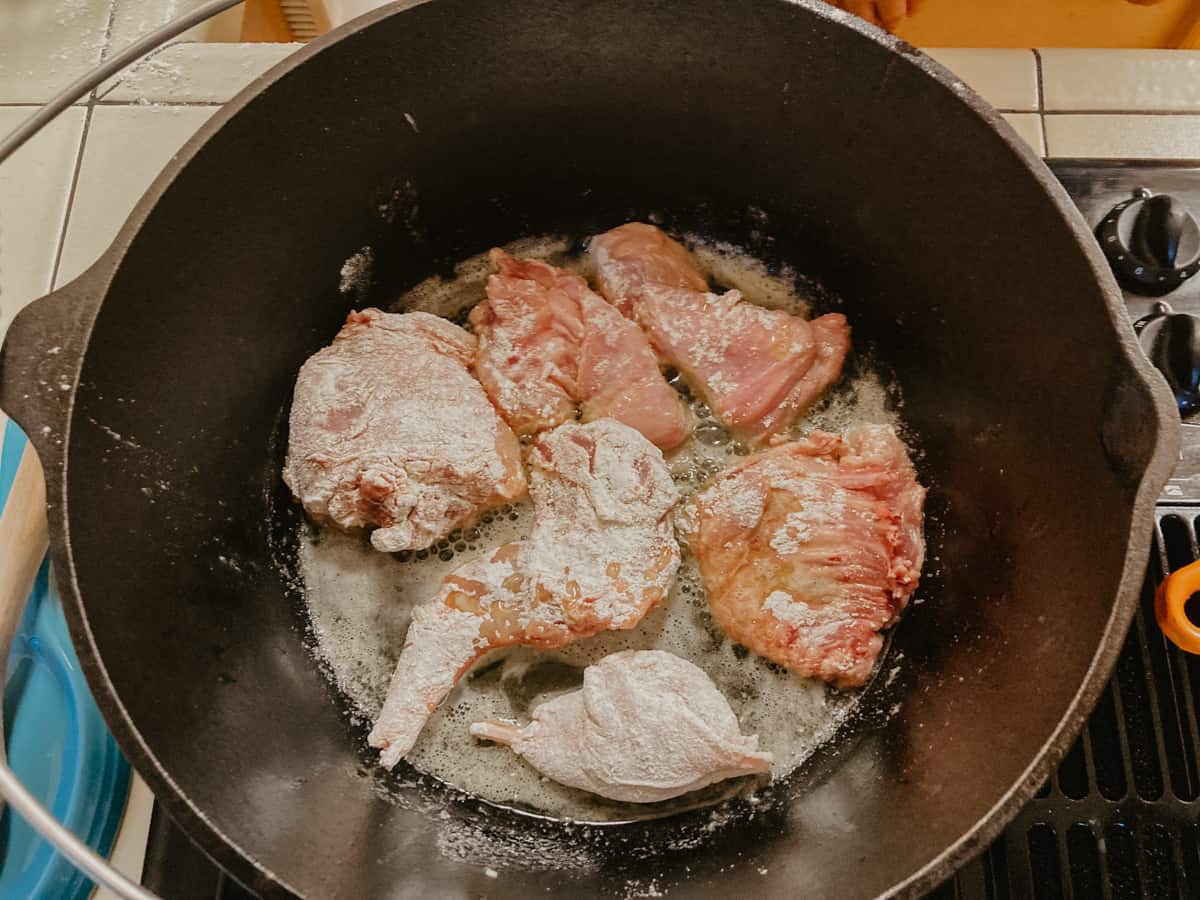
5. Add the Rabbit to the Pot
Place the rabbit pieces in the pot and cook for about 5 minutes. Turn them frequently to cook both sides of the meat.
While they are cooking, proceed to the next step.
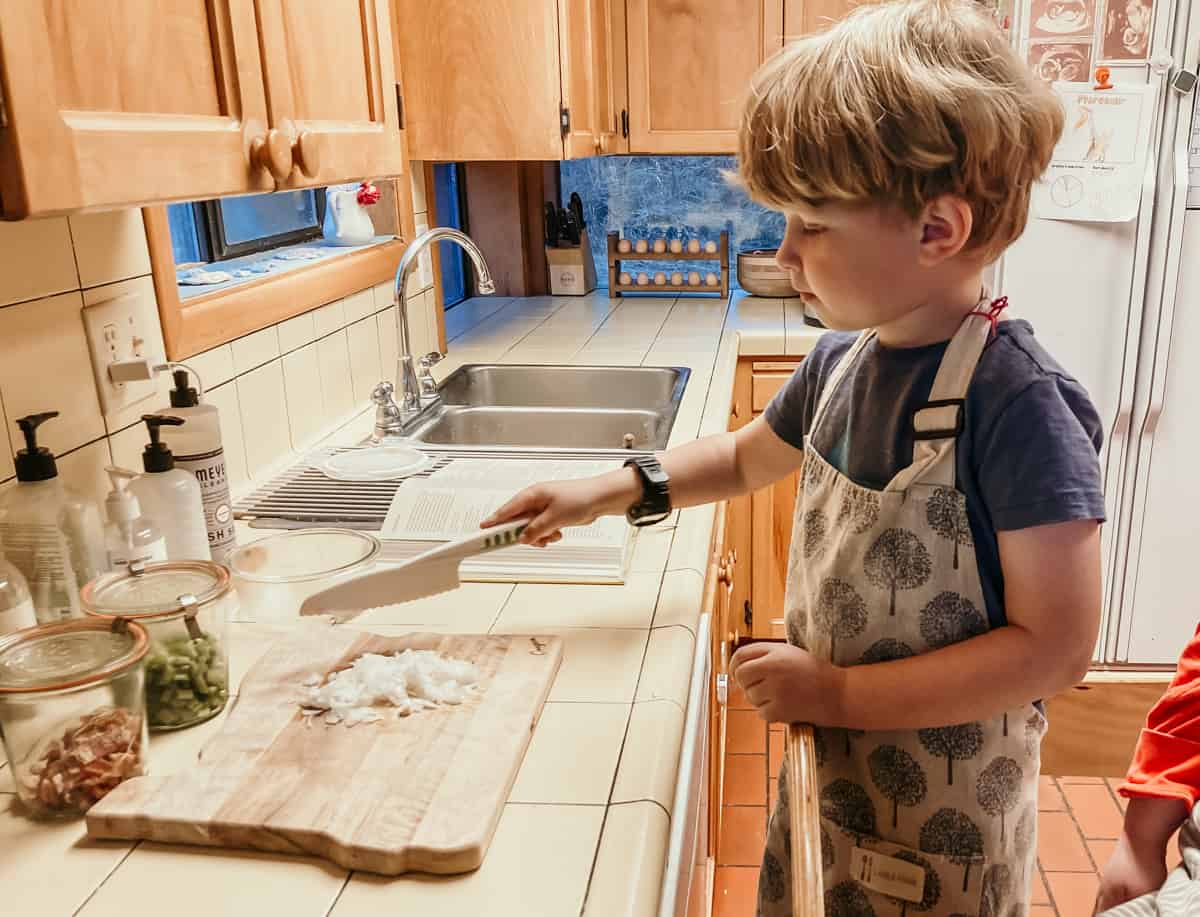
6. Chop the Vegetables Needed for the Rabbit Stew Recipe
Chop the onion, garlic, carrots, celery, mushrooms, and tomatoes. Now is a good time to cut the pancetta or bacon into small pieces as well.
We had some cooked bacon and some celery leftover from a previous meal so that cut down on our prep time.
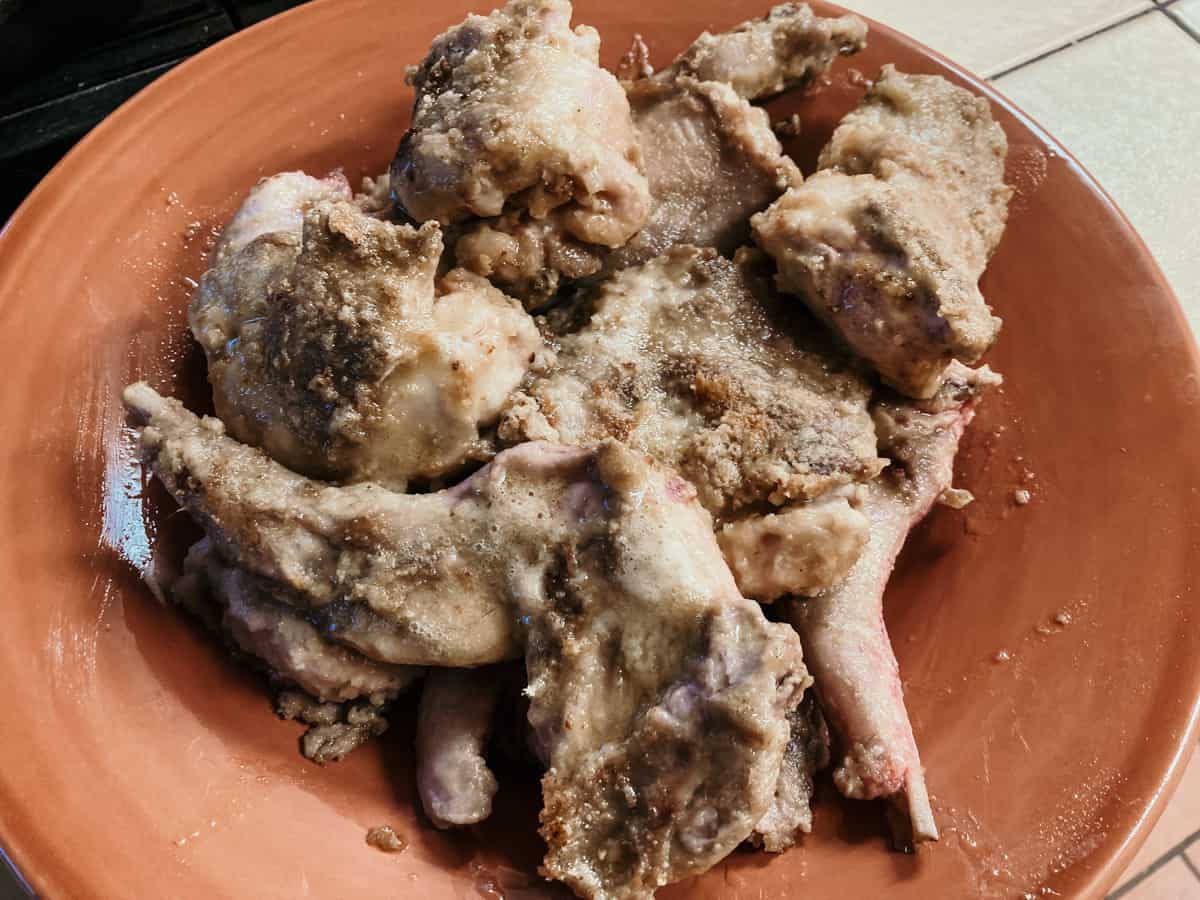
7. Remove the Rabbit When the Outside is Golden Brown
When all of your rabbit pieces are golden, use the tongs to transfer them to a large plate and set aside.
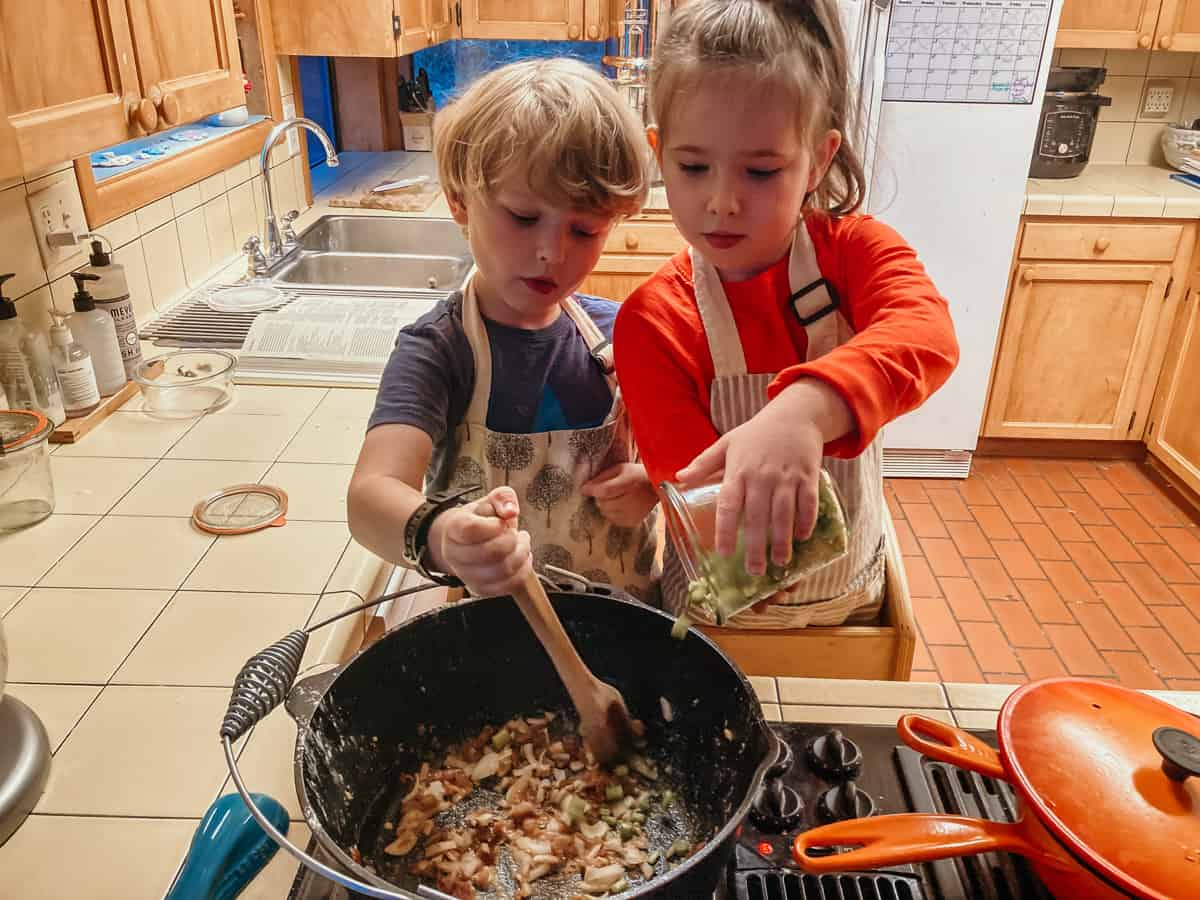
8. Add the Vegetables to the Dutch Oven
Add the pancetta to the pot. Cook for 2-3 minutes, stirring while it cooks.
If you're using cooked bacon like us you can add that along with the onion, garlic, carrots, and celery to the pot.
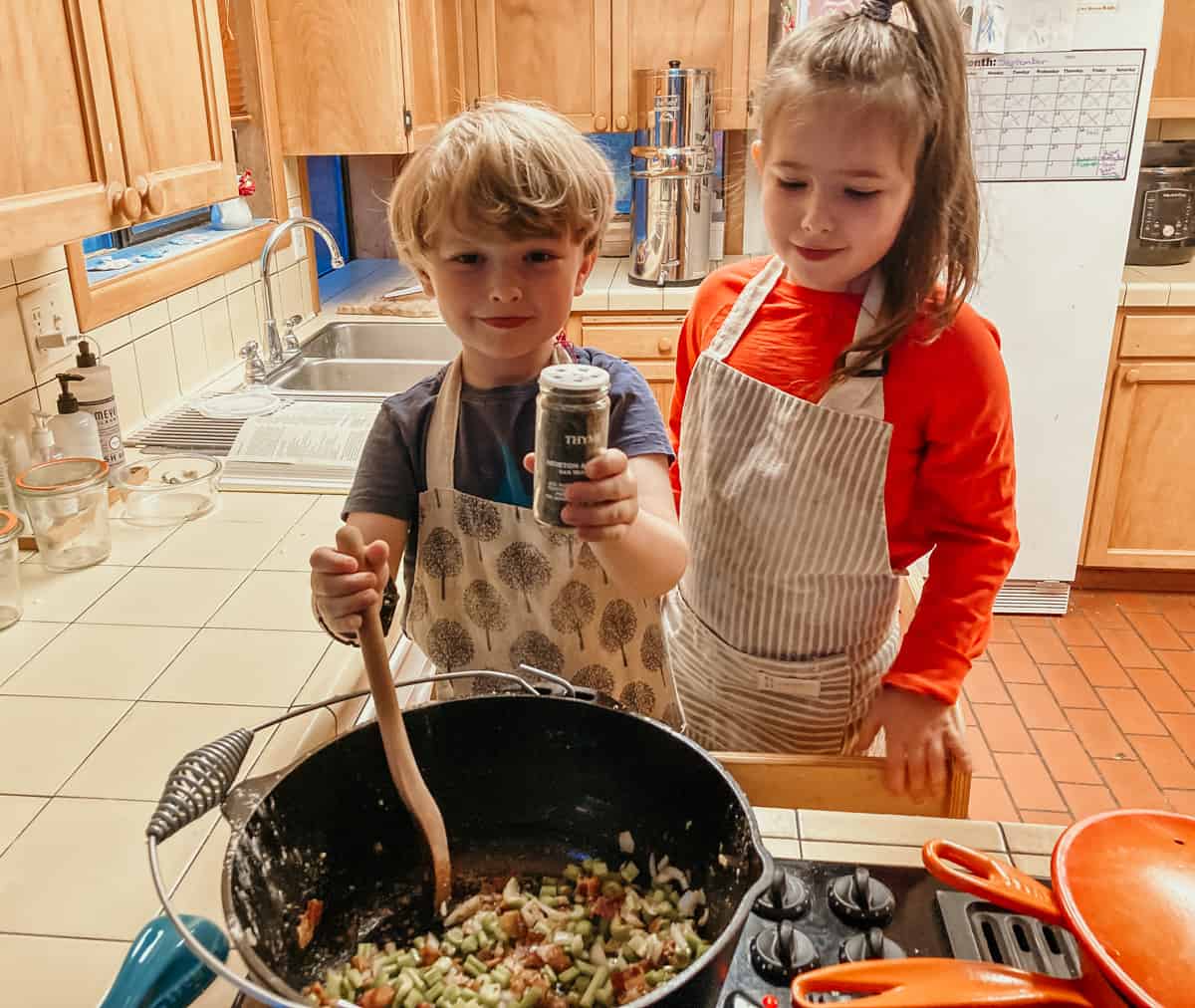
9. Thyme for Rabbit Stew
Add the thyme to the dutch oven.
If your kids are learning about homophones, this is a great time to talk about thyme.
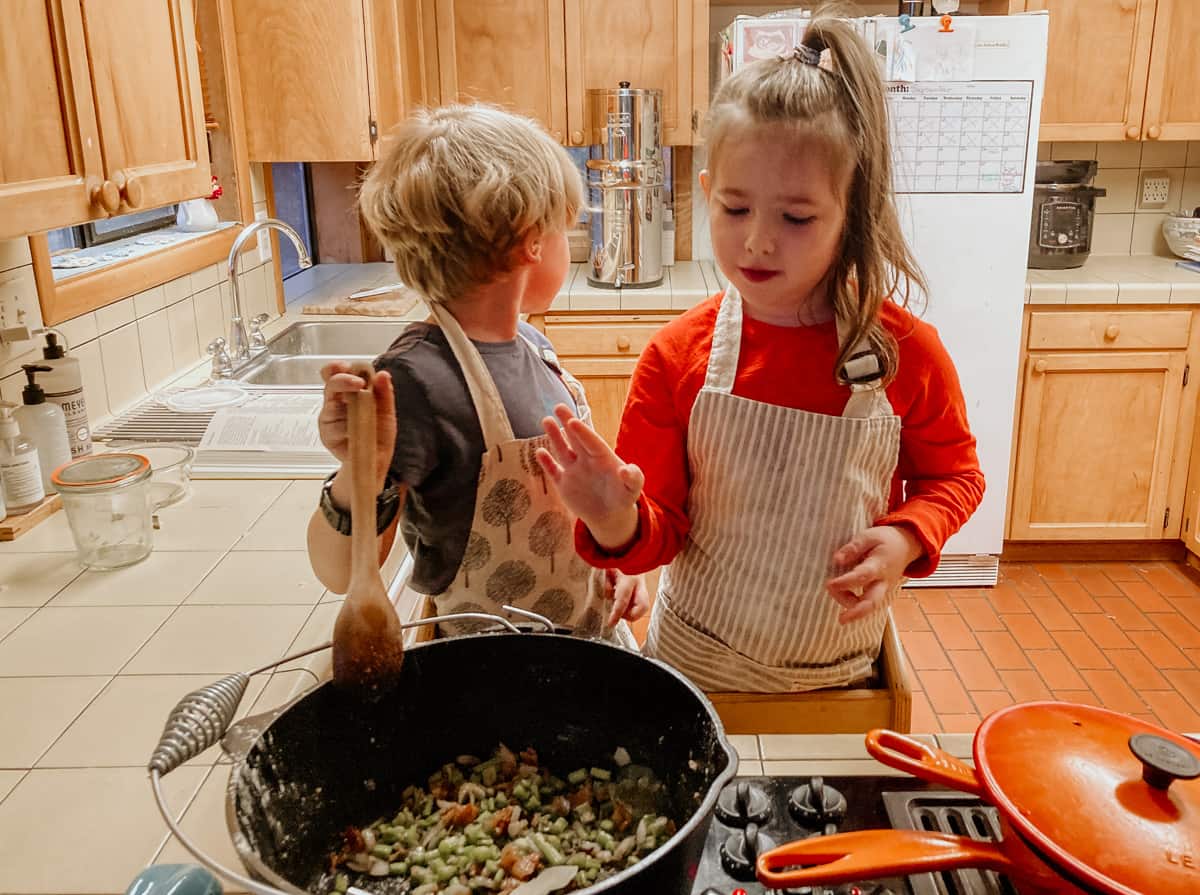
10. Add the Bay Leaves to the Rabbit Stew Ingredients
Our oldest likes to flick them in with her thumb and index finger. Let the ingredients cook for 5 minutes. Stir the vegetables frequently until they are golden.
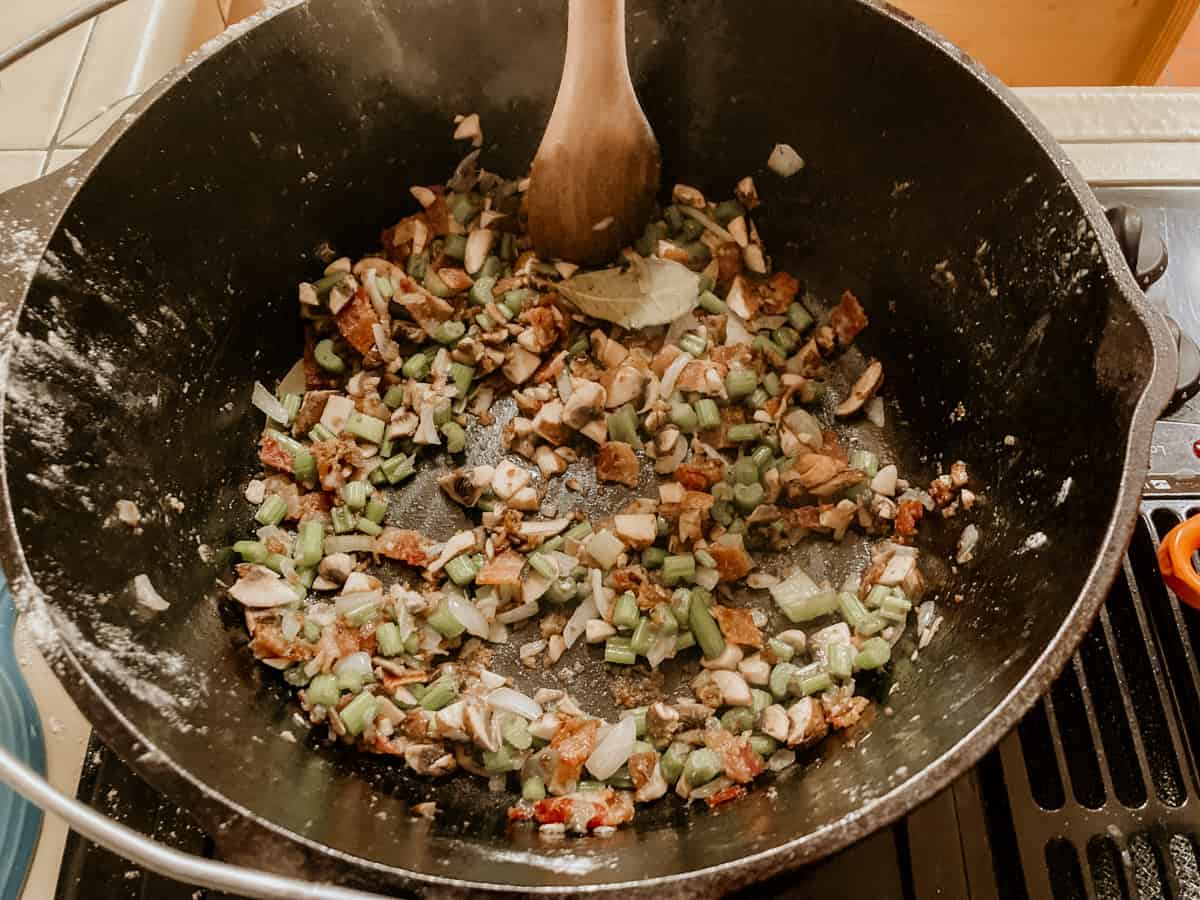
11. Add the Mushrooms to the Pot
Cook for 5 minutes. The mushrooms should be dark and soft.

12. Add the Wine to the Dutch Oven
Turn the stove heat up to high. Add the red wine. We used a pinot noir but any dry red wine will do.
Our kids noticed the strong smell of the wine and wondered how it would affect the flavor of the stew.
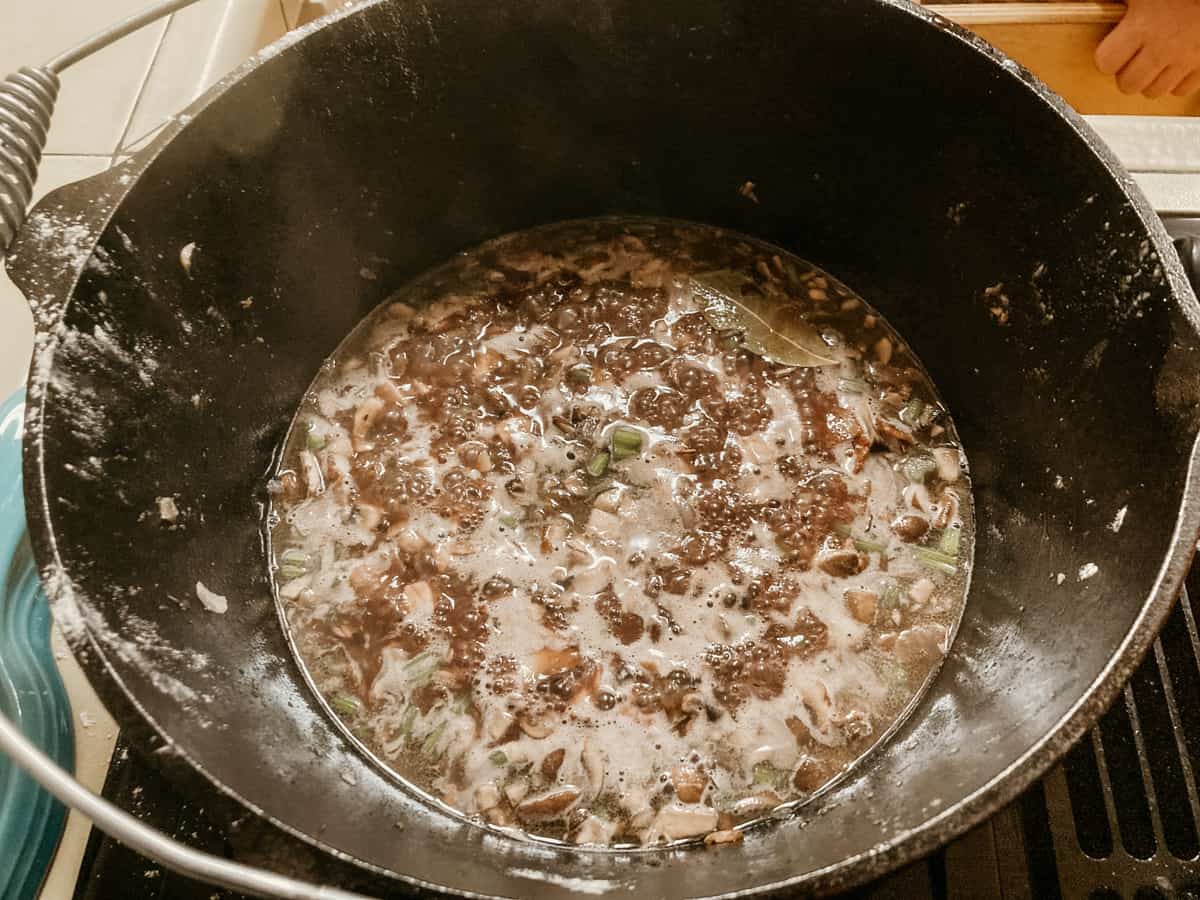
13. Bring the Pot to a Boil
Stir the ingredients to remove any pieces from the bottom of the pot. Allow it to boil for about 5 minutes. There should be little to no wine remaining in the pot.
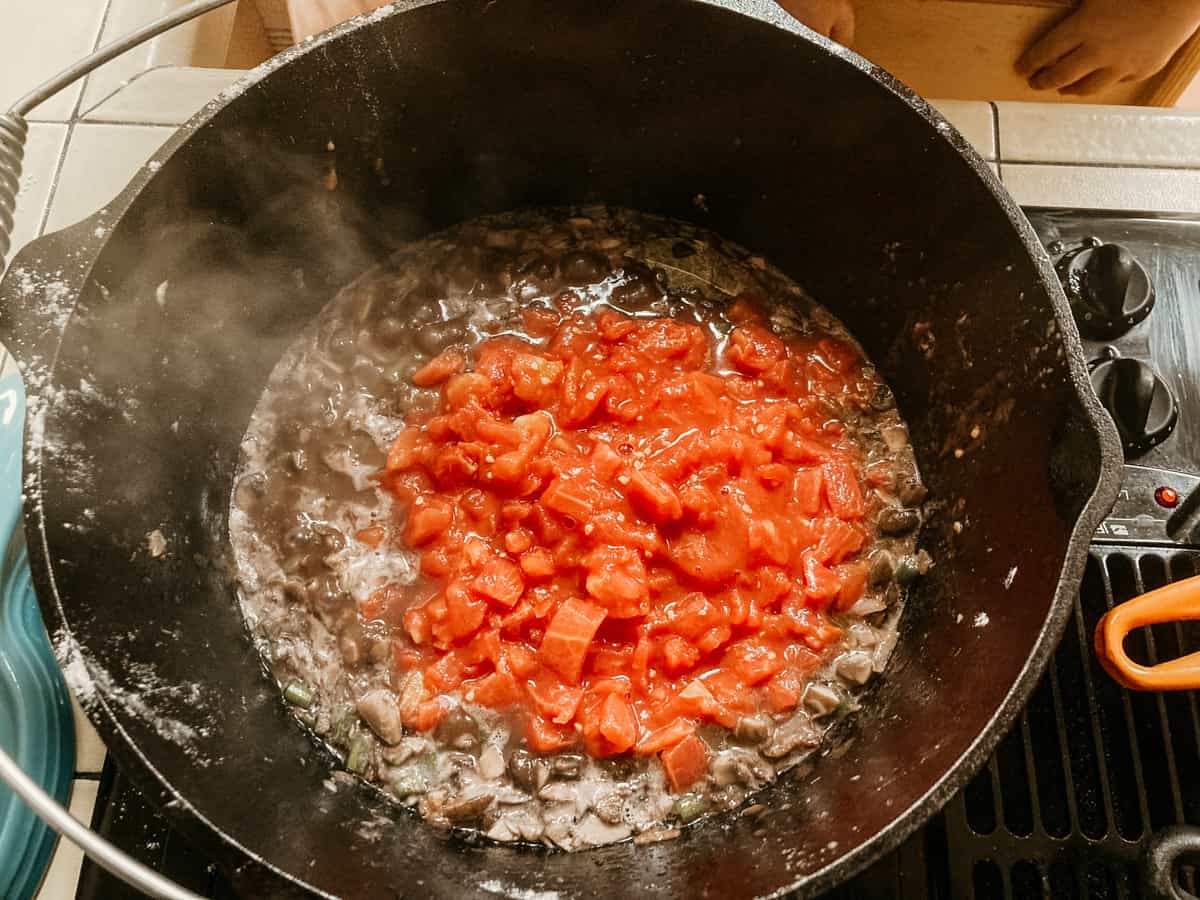
14. Add the Tomatoes to the Rabbit Stew Ingredients

15. Add the Chicken Stock and Bring to a Boil
Add the chicken stock or broth and half of the parsley. Give it a good stir and let it come to a boil.
While you're waiting, turn the oven to 325 degrees Fahrenheit, 160 degrees Celsius.

16. Place the Rabbit Pieces Back in the Pot
Turn off the stove.
Place the rabbit pieces back in the pot, and turn them to coat them in the sauce. Cover the pot with a lid or aluminum foil.
Place the pot in the oven and allow it to cook for 2 hours. The rabbit should be cooked through and tender.
Remove the pot from the oven and add the remaining parsley on top.
Don't forget to turn off the oven.
Serve hot with your smashed or mashed potatoes.
Conclusion for Australian Rabbit Stew
This tasty rabbit stew recipe is a lot of fun to make and the opportunities to extend the learning are endless. What do you think? Would you like to try this at home with your family? If you do, come back and let us know how it went.
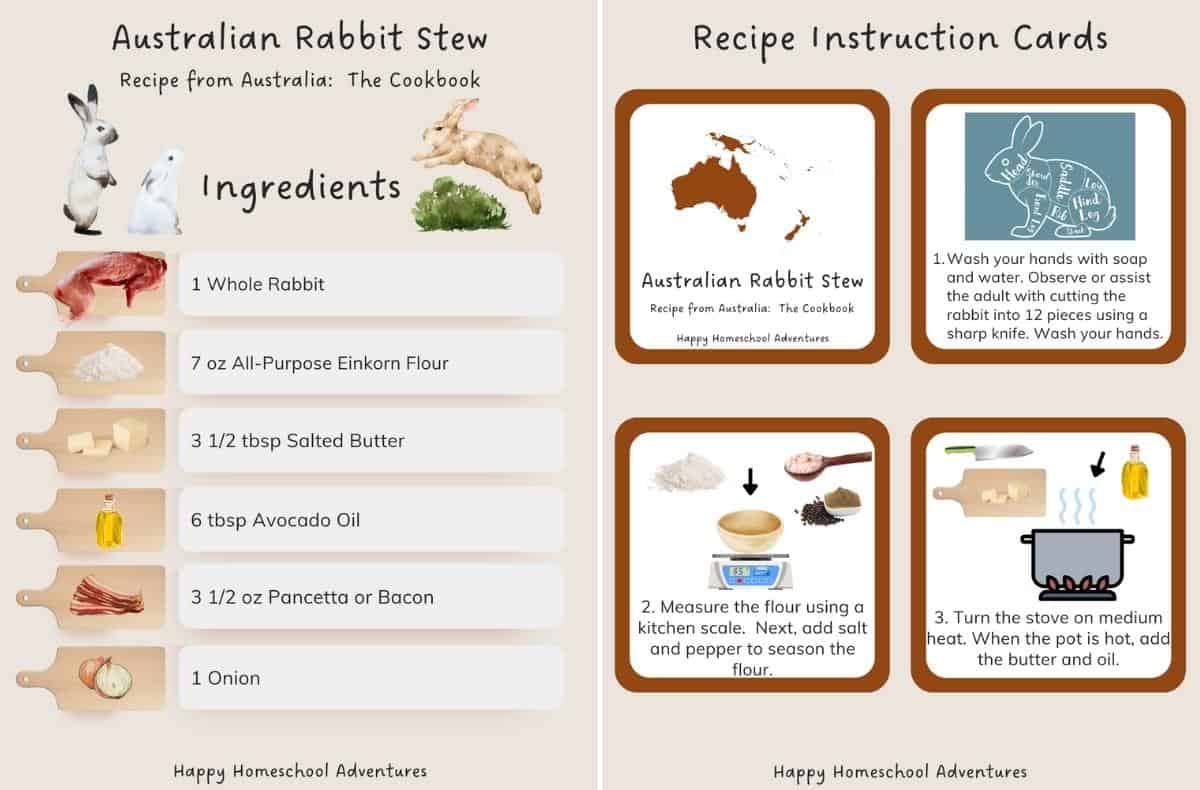
Free Australian Rabbit Stew Recipe for Pre-Readers and Up
Grab your free printable recipe cards above. Kids can gather ingredients using the ingredient list, gather their equipment with the tools list, and prepare the meal using the step-by-step recipe cards, with assistance as needed.
The cards are easy to use, include pictures, and encourage confidence and independence in the kitchen. They also make an excellent addition to your Montessori continent box for Oceania.
Montessori Continent Boxes
Explore every continent with these solid maple hardwood boxes.
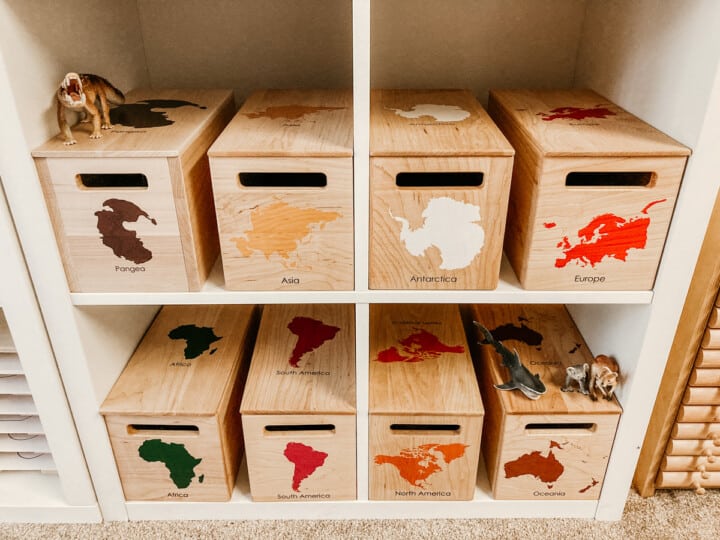

Australian Rabbit Stew
Equipment
- Sheet Pan or Large Plate
- Dutch Oven or Large Ovenproof Pot
- Spoon
- Learning Tower as needed
Ingredients
- 1 whole rabbit
- 7 oz all-purpose einkorn flour
- 3 ½ tablespoon salted butter
- 6 tablespoon avocado oil
- 3 ½ oz pancetta or bacon
- 1 onion
- 3 cloves garlic
- 2 carrots
- 2 stalks celery
- 2 teaspoon thyme
- 2 bay leaves
- 14 oz portobello mushrooms
- 1 ⅓ cups pinot noir or other dry red wine
- 28 oz whole tomatoes
- ½ cup chicken stock or broth
- ¾ oz parsley
- salt
- pepper
Instructions
- Wash your hands with soap and water prior to getting started. First, the hind legs are removed at the joint. Cut the hind legs crosswise in the center to separate the shanks. Next, the front legs are removed to give you 2 more pieces. Finally, the saddle is cut in half lengthwise down the center, and then each half is cut into 3 pieces, for a total of 6 pieces. You can save the backbone for making bone broth and wash your hands. Kids can explore the cookbook as they observe.
- Weigh the flour using a kitchen scale. Add salt and pepper to season the flour.
- Turn the stove on medium heat. When the dutch oven or pot is hot, add the butter and oil. When the butter has melted, you're ready for the next step.
- Coat the pieces in the flour. Kids can place each piece in the flour mixture and then flip them over to coat the other side.
- Place the rabbit pieces in the pot and cook for about 5 minutes. Turn them frequently to cook both sides of the meat. While they're cooking proceed to the next step.
- Chop the onion, garlic, carrots, celery, mushrooms, and tomatoes. Now is a good time to cut the pancetta or bacon into small pieces as well.
- When all of your rabbit pieces are golden, use the tongs to transfer them to a large plate and set aside.
- Add the pancetta to the pot. Cook for 2-3 minutes, stirring while it cooks. If you're using cooked bacon, you can add that along with the onion, garlic, carrots, and celery to the pot.
- Add the thyme to the dutch oven. If your kids are learning about homophones, this is a great time to talk about thyme.
- Add the bay leaves to the dutch oven. Let the ingredients cook for 5 minutes. Stir the vegetables frequently until they are golden.
- Add the mushrooms to the pot. Cook for 5 minutes. The mushrooms should be dark and soft.
- Turn the stove heat up to high. Add the red wine.
- Stir the ingredients to remove any pieces from the bottom of the pot. Allow it to boil for about 5 minutes. There should be little to no wine remaining in the pot.
- Add the tomatoes to the rabbit stew ingredients.
- Add the chicken stock or broth and half of the parsley. Give it a good stir and let it come to a boil. While you're waiting, turn the oven to 325 degrees Fahrenheit, 160 degrees Celsius.
- Turn off the stove. Place the rabbit pieces back in the pot, and turn them to coat them in the sauce. Cover the pot with a lid or aluminum foil. Place the pot in the oven and allow it to cook for 2 hours. The rabbit should be cooked through and tender. Remove the pot from the oven and add the remaining parsley on top. Don't forget to turn off the oven. Serve hot with your smashed or mashed potatoes.
Notes
- Wash tools and equipment after touching raw meat
- Do not rinse raw meat
- Wash produce under running water
- Use a vegetable brush to scrub firm produce
- Use caution when preparing this meal with kids as bones are a choking hazard
- Don't leave food sitting out at room temperature for extended periods
- Never leave cooking food unattended
- Use oils with high smoking point to avoid harmful compounds
- Always have good ventilation when using a gas stove
- See more guidelines at USDA.gov.
- Full Lesson Info and Pictures at: https://happyhomeschooladventures.com/rabbit-stew
Nutrition
Estimated nutrition information is provided as a courtesy and is not guaranteed.

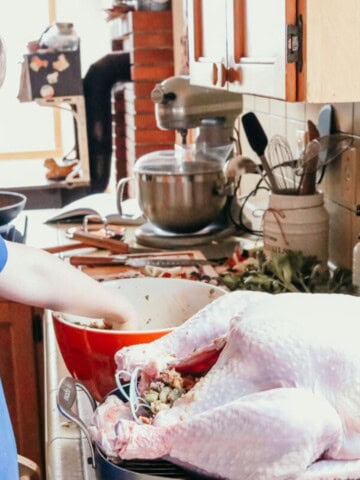
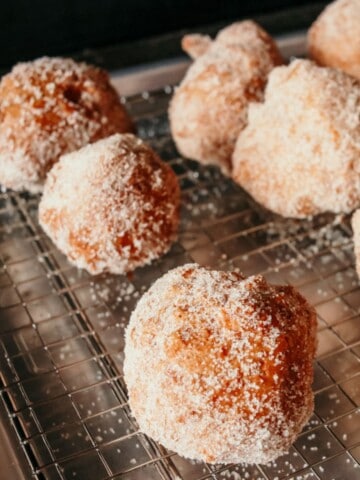
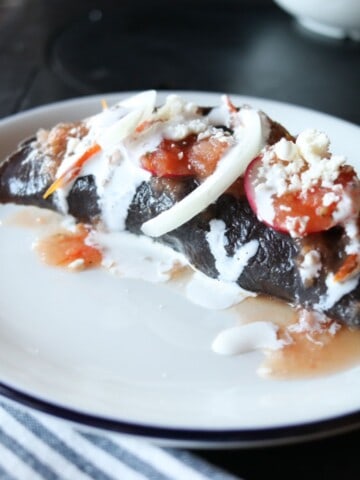
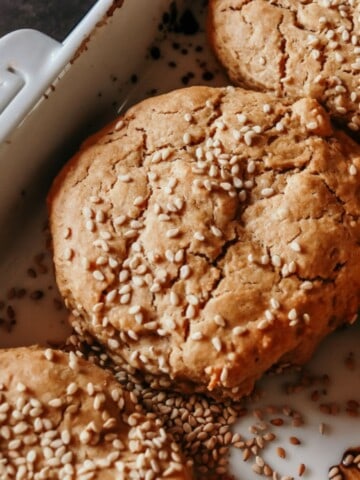
Leave a Reply